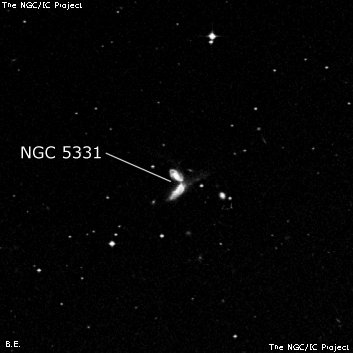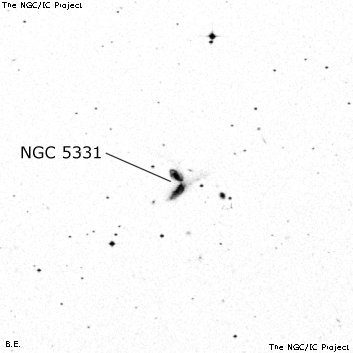NGC/IC Project Restoration Effort
(This is a very very beta version)
NGC5331


Basic Information
Location and Magnitude
Right Ascension: 13:52:16.0
Declination: +2:6:4
Constellation: VIR
Visual Magnitude: 13.8
Historic Information
Discoverer: Herschel W.
Year of discovery: 1793
Discovery aperture: 18.7
Observational
Summary description: vF, S, E 0°, rr
Sub-type: Sb
Corwin's Notes
=====
NGC 5331. While there is no doubting the identification with an interacting
pair of galaxies oriented north-south -- both WH's and JH's positions are good
-- JH's description on 13 April 1828 is a bit strange: "A very insignificant
cluster of vS scattered stars; or a S resolved neb." In the very next sweep
on the following night, he was not even that sure about the object: "The
faintest thing imaginable; sky turbid. Not found till too late for the
transit, and seen with difficulty."
Given that, he adopted his father's description, "vF, S, E mer[idian]", for
the GC adding only "rr" to suggest the resolvability he suspected in his first
observation.
I'm curious about the phrase "scattered stars"; did he mean to include some of
the field stars around the galaxy pair? I don't really see anything beyond
the usual high Galactic latitude field stars here, so will stick with the
pair for the NGC object. That is certainly the object that WH found, so is
clearly the object Dreyer meant for the NGC.
But JH's note still seems curious to me ...
Steve's Notes
=====
NGC 5331
48" (5/4/16): at 697x; NGC 5531 is a fascinating interacting pair (25" between centers) with a third component (CGCG 017-081) 1.3' W. The northern component (VV 253b = PGC 49266) is fairly bright, moderately large, elongated 2:1 or 5:2 SW-NE, 30"x12", sharply concentrated with a prominent, elongated core and bright stellar nucleus. The surface brightness of the halo is irregular with a hint of spiral structure.
The southern galaxy (highly disrupted on the SDSS with a tidal plume to the WNW) is fairly bright, fairly large, elongated 3:1 NW-SE, broad concentration but no well defined zones. The surface brightness, though, is irregular or mottled and the galaxy appears dusty. More unusual is the shape; the galaxy tapers at the southeast east and the northwest end bends or twists towards the northern spiral, creating a kidney-bean outline.
CGCG 017-081, 1.3' W, appeared fairly faint, small, round, 15" diameter, nearly even surface brightness. A mag 15.7 star is just 14" WSW of center. A mag 16 star sits midway between this galaxy and the NGC 5331 pair.
17.5" (5/11/96): this double system was resolved with the brighter component (VV 253b) at the north end. VV 253b is fairly faint, fairly small and slightly elongated. Attached at the south end is a low surface glow (VV 253a). The pair requires attention as there is less than 30" separation between centers. NGC 5329 lies 14' N.



